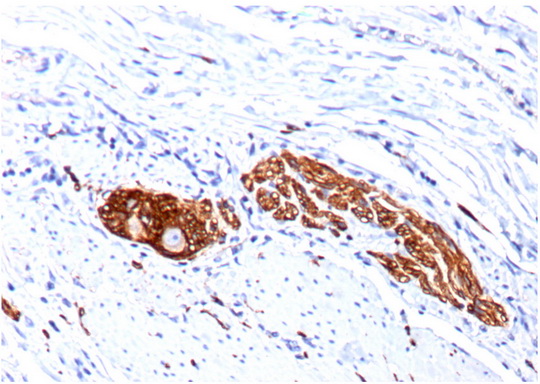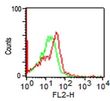CD56 Mouse Monoclonal Antibody [Clone ID: SPM128]
Specifications
| Product Data | |
| Clone Name | SPM128 |
| Applications | FC, IF, IHC, IP, WB |
| Recommended Dilution | ELISA: Use BSA free antibody for coating. Flow Cytometry: 0.5-1.0 µg/106 cells. Immunofluorescence: 1-2 µg/ml. Immunoprecipitation: 1-2 µg/500 µg protein lysate. Western Blot: 0.5-1 µg/ml. Immunohistochemistry on Frozen and Formalin-Fixed Paraffin Sections: 0.5-1 µg/ml for 30 min at RT. Staining of formalin-fixed tissues requires boiling tissue sections in 10mM Citrate Buffer, pH 6.0, for 10-20 min followed by cooling at RT for 20 minutes. Recommended Positive Control: Cerebellum, Pancreas, Neuroblastoma. |
| Reactivities | Human, Rat, Zebrafish |
| Host | Mouse |
| Isotype | IgG1 |
| Clonality | Monoclonal |
| Immunogen | Membrane preparation of a small cell lung carcinoma. |
| Specificity | This Monoclonal Antibody reacts with an extracellular domain (close to transmembrane) of CD56/NCAM. Three isoforms of neural cell adhesion molecule (NCAM) are produced by differential splicing of the RNA transcript from a single gene. The 135kDa isoform is the basic molecule, which is glycosylated or sialylated to produce the mature species. Anti-CD56 recognizes two proteins of the neural cell adhesion molecule, the basic molecule expressed on most neuroectodermally derived tissues and neoplasms (e.g. retinoblastoma, medulloblastomas, astrocytomas, neuroblastomas, and small cell carcinomas). It is also expressed on some mesodermally derived tumors (rhabdomyosarcoma). Anti-CD56 plays an important role in the diagnosis of nodal and nasal NK/T-cell lymphomas. Cellular Localization: Cell Surface. |
| Formulation | 10mM PBS State: Purified State: Liquid purified IgG fraction from Bioreactor Concentrate Stabilizer: 0.05% BSA Preservative: 0.05% Sodium Azide |
| Concentration | 0.2 mg/ml |
| Purification | Protein A/G Chromatography |
| Predicted Protein Size | 180, 145 and 125 kDa |
| Background | The CD56 molecule is a cell surface glycoprotein which is expressed on neuroendocrine cells, natural killer cells and a subset of T cells in the peripheral blood. Three main isoforms of CD56 exist. Neurons express the largest 180kD form, while haemopoietic cells express the 140kD isoform. In neuronal tissues, CD56 mediates homophilic and heterophilic adhesion and is implicated in neural development. Studies suggest that CD56 is also expressed on thyroid follicular epithelium and may play a role in autoimmune disease of the thyroid. CD56 is expressed in a range of tumours including tumours of the lung, neural derived malignancies and natural killer cell lymphomas. |
| Synonyms | NCAM-1, N-CAM-1, NCAM |
| Reference Data | |
Documents
| Product Manuals |
| FAQs |
| SDS |
{0} Product Review(s)
0 Product Review(s)
Submit review
Be the first one to submit a review
Product Citations
*Delivery time may vary from web posted schedule. Occasional delays may occur due to unforeseen
complexities in the preparation of your product. International customers may expect an additional 1-2 weeks
in shipping.






























































































































































































































































 Germany
Germany
 Japan
Japan
 United Kingdom
United Kingdom
 China
China




